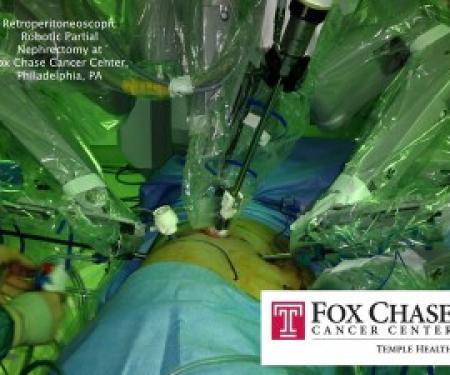Fox Chase surgeons offer a broad range of surgical techniques to treat patients with cancer.
Some of these techniques include:
- Conventional Open Surgery: A procedure in which the surgeon cuts the skin and tissues to gain direct access to the tumor. Recovery can take a long time, as nearby tissue and organs may be affected. Stitches are required to close the incision and limit bleeding. Many complex cases still require open surgery and Fox Chase surgeons have extensive experience in these procedures.
- Laparoscopic Surgery: The surgeon inserts a small telescope-like viewing tube (laparoscope) and surgical instruments through a "keyhole" incision near the belly button. The surgeon's hands manipulate the instruments while he or she views a magnified surgical field on a two-dimensional video monitor. Fox Chase is among the first hospitals in the nation to offer laparoscopic surgery for cancers of the liver, pancreas, bile-ducts and gallbladder.
- da Vinci® Robotic Surgery: Robotic surgery is the "next generation" of laparoscopic surgery. A robot's arms hold the surgical tools, which the surgeon controls while seated at a console. With a three-dimensional view of the surgical field, the surgeon gains a better image and precision.
Specialized Techniques
- Groin Lymph Node Dissection: The removal of lymph nodes and all tissue from the groin region that may contain tumors. Fox Chase Cancer Center is one of only a few centers in the country that offers a minimally invasive approach.
- HIPEC: Hyperthermic Intraperitoneal Hemotherapy (HIPEC) is a unique option in lieu of, or in addition to, traditional chemotherapy. Following the surgical removal of visible tumors in the abdomen (debulking), the abdominal cavity is bathed with a heated chemotherapy solution for up to ninety minutes in the operating room. The chemotherapy is heated to make the tumor more sensitive to the drug. The goal of this approach is to destroy any remaining microscopic cancer cells and prevent recurrence.
- Isolated Limb Infusion: With ILI, the effects of chemotherapy can be concentrated regionally in one area, easing the strain and toxicity on the full body that can accompany standard chemotherapy.
- Retroperitoneoscopic Robotic and Laparoscopic Surgery: Some patients have had significant previous abdominal surgery and traditional laparoscopic/robotic surgical approaches may be too risky due to existing internal scar tissue. Moreover, patients with tumors on the back (or posterior) side of the kidney may need to have the entire kidney rotated in order for the surgeon to reach the tumor through traditional minimally invasive techniques. In these specific cases, retroperitoneoscopic or retroperitoneal laparoscopic/robotic surgical approach makes minimally invasive surgery possible.

